Citrus depressa
| Citrus × depressa | |
|---|---|

| |
| Shīkwāsās on a tree | |
| Scientific classification | |
| Kingdom: | Plantae |
| Clade: | Tracheophytes |
| Clade: | Angiosperms |
| Clade: | Eudicots |
| Clade: | Rosids |
| Order: | Sapindales |
| Family: | Rutaceae |
| Genus: | Citrus |
| Species: | C. × depressa
|
| Binomial name | |
| Citrus × depressa | |
Citrus depressa (Citrus × depressa, formerly C. pectinifera, Okinawan: シークヮーサー or シークァーサー shiikwaasa, Japanese: ヒラミレモン hirami remon or シークワーサー shīkuwāsā), in English sometimes called shequasar, Taiwan tangerine, flat lemon, hirami lemon, or thin-skinned flat lemon[citation needed], is a small, green citrus fruit rich in flavonoids and native to Taiwan and Okinawa, Japan.
Very sour, it is often used like lemon or lime to garnish dishes, but is also used to make jam, or a yellow juice, which can be thinned or sweetened.
Its name is occasionally translated into English as kalamansî, but strictly speaking, this is a different fruit.
Description
Citrus depressa is grown in Taiwan and Ryukyu Islands. This flat lemon is a flowering tree with an average height of 5m. The appearance is similar to Calamondin. The flowers, white and about 3 cm in diameter, usually bloom in April. The fruit, which appear around July, weigh about 25~60g. Unripe, the skin is a dark green, which becomes yellow during ripening. The fruits have a very low sugar content and are very sour.
External links
 Data related to Citrus depressa at Wikispecies
Data related to Citrus depressa at Wikispecies
